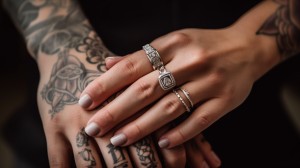Planning a wedding is a ton of work, and that’s in “BC” times (before COVID). Wedding planning in 2021? Hoo-boy …
If you haven’t heard, the wedding world has changed, but let us be the first to tell you: #loveisnotcancelled. Kick off your shoes and get comfy, because we’ve got a lot to share with you about weddings in 2021.
This ultimate guide isn’t limited to only COVID weddings. The information here is all-encompassing, constantly updated, and shares everything you need to know about taking the biggest and smallest steps when planning your wedding. Bookmark us now, ‘cause it’s about to get more complex than a rapidly evolving COVID outbreak public safety policy. With double masks.
If you’re not yet engaged but are getting a jumpstart on learning the wedding planning ropes (we all did it), you might want to read our write up on Getting Engaged: How To Propose & Other Rings … Errr, Things.
COVID Weddings
If 2020 weddings taught us anything, it’s that:
- You CAN still get married during a pandemic, but you have to be open to a different kind of wedding. We’ll get into what that means in detail here shortly.
- COVID weddings are less about the things TO do, and much heavier on the “what not to do” side. That will continue to hold true as long as COVID pervades the world.
Should I Postpone My Wedding For COVID?
The first wedding planning question brides and grooms are asking is whether or not they should wait until after COVID to tie the knot.
According to the Brides American Wedding Study:
- 66% of would-be pandemic brides postponed their weddings
- 36% still walked down the aisle
For those doing the math at home, that adds up to 102%, likely due to some confusion: many people decided to get legally married first (with a small or no ceremony), saving their big ceremony plans for down the road, when it’s safe.
Let’s explore your options.
To postpone…
If you are considering getting married in 2021, or at any point while COVID’s infection rates are above a threshold considered safe for gathering in your jurisdiction, immediately forget about having a big ceremony. Just don’t.
2020 saw countless wedding celebrations turn into COVID superspreader events, resulting in thousands (yes, thousands) of COVID cases, and even deaths. Do not let your loved ones become a statistic. With vaccine distribution making headway, a future of freedom awaits.
Postponing the wedding is a good idea for safety-conscious brides and grooms who want to fulfill a specific vision. It’s not unreasonable to insist that your dream of 200 guests shaking it together to “Love Shack” becomes a reality—you can hold out for that day and there’s nothing wrong with it!
This will (hopefully) be the only time you get married and you should do it your way. If your significant other is truly “the one,” why rush?
Or not to postpone…
Now let’s discuss why NOT to wait—that is, if you’re okay with keeping it small. The wedding industry is down right now, but it will come back, and with gusto. That means:
- Lower prices now, higher prices later.
- Booking availability now, harder to book later.
COVID has changed how we get married. Small doesn’t equal less. In fact, we’ve seen a lot of demonstrations that “small” actually means more.
More for you and your partner because you’re not dropping $3k to offer your guests eating utensils with their meal. More creative wedding trends, with more DIY, micro weddings, boutique elopement experiences, Zoom wedding celebrations, and “maybe never” weddings.
As our quarantined state finds its way to the exit, it will leave in its wake a forever-changed wedding terrain. Is your bride brain ready to flex? Here are the best 2021-2022 wedding trends …
Wedding Types & Ideas
We’re covering just about every category of alt-wedding, all of which can jive nicely with social distancing and COVID-19 safety protocols.
- Micro Weddings
- Minimonies
- Sequel Celebrations
- Elopements
- Intimate Civil Ceremonies
- Zoom or Online Streamed Weddings
- Traditional Weddings
There’s some confusion around what differentiates a micro wedding from a minimony from an elopement, so let’s set the record straight. We’re only going to hear more about each as their popularity soars in the new era of weddings.
Micro Weddings
Take a traditional wedding, shrink it to 50 or fewer of your closest pals and family, and you’ve got a micro wedding.
A micro wedding is generally more budget-friendly than its most comparable counterpart: a traditional nuptial ceremony and reception with a large guest list. However, some couples may choose to spend their excess budget on special details that wouldn’t scale well to a larger guest list (or to the wallet of whoever is paying for the wedding).
Here are some creative examples of micro wedding ideas with big ideas and noteworthy upgrades:
- Host your guests’ room and board.
- Top shelf food, liquor, or entertainment
- A totally unique location, either far away (destination wedding) or local but unexpected (gallery, theatre, or renowned local spot)
- Over the top something (ex: floor-to-ceiling floral installation)
- Meaningful guest favors (bottle of wine, tickets to a local event, group skydiving lessons)
Practical couples will pocket the extra cash and put it to use elsewhere, saving it for the downpayment on a house, investing it in the stock market, keeping it for emergency savings, or maybe even for their future kids’ college funds.
Minimony
Eeny-mini mony-mo, catch a garter by the toe …
Much to our disappointment, a minimony does not involve physically miniature anything. It doesn’t even encourage gerbil-scale flower arrangements! For that, we are disappointed. Otherwise, it’s a lovely way to tie the knot.
The minimony is a miniature ceremony and nothing much more. It’s arguably the most important part of any wedding—and certainly the most required to call any wedding “official.”
Why would a couple choose to limit their nuptials to the commitment portion? The most obvious reason right now is COVID. A minimony might be used to honor the original planned wedding date, with a post-COVID-valid raincheck on the reception.
It may be in-person with limited attendance (10 or 20 max), or virtual, with guests taking a 20 minute Netflix break to tune in from the safety of their home.
There are ways of incorporating traditional wedding elements into a minimony, despite its barebones reputation. Two of the most popular are first dances and virtual rice-throwing on Zoom. We can only hope there aren’t any faceless objections to the “joining of these two people” from the black square of anonymous guest “Liger-King865.”
The minimony’s greatest appeal is that it can get the job done in meaningful ways (with as many guests as you want in attendance, if you capture the moment on screen), and it can also act as a teaser to an eventual full-on wedding celebration.
Sequel Celebration
“Sequel wedding” and “sequel celebration” were originally coined not in response to a COVID wedding trend, but as the name of a second separate and distinct wedding many couples have for reasons either religious, cultural, or geographical.
If you want that big celebration but you don’t want to wait another year or two to actually be married, have your wedding cake and eat it, too! TWICE.
A sequel wedding can be anything you want it to be. Regardless of whether it’s pandemic-induced, cultural, religious, or something else, you need not feel guilt for throwing a sequel celebration. If you’re only planning to get married once, don’t convince yourself into an intimate civil union if you want something more.
If the parameters of COVID-safe wedding options don’t fulfill your dreams, you needn’t compromise. You just need to wait. Trust us, after a couple years of being socially cut off and sequestered in their homes, your guests will be THRILLED to come out and play.
Elopement
Elopement weddings have been on the rise in recent years, and not just due to our current global health predicament. Elopements were historically considered “sneaky” events, wherein the couple spontaneously jets off to Vegas to have their officiant pronounce them married after dropping out of a plain in a studded, white suit, dark, thick-rimmed sunglasses, and a coif of hair you could surf on.
But now, a boutique wedding market has emerged to bring elopement into new territory that appeals to couples of every type. Businesses from all-inclusive resorts to private lodges and venues offer elopement packages to fit any couple’s needs.
Intimate Civil Ceremony
The culture of tradition in the wedding industry remains strong, but growing in strength alongside it is permission to throw the wedding playbook aside and get married however you want to.
An intimate civil ceremony is no longer synonymous with cause for concern. Long-held assumptions about why anyone would choose to break from tradition and honor their relationship privately are no longer the norm (and where those judgements and assumptions do exist, they can be told to screw off).
Zoom Weddings
Less than tech-savvy readers may think “Zoom” weddings refer to the speed at which they’ve begun and finished, but on the contrary, they’re named for the online video calling software that skyrocketed into popularity in 2020. Although many competing companies offer streaming video solutions, the name “Zoom Weddings” has stuck.
Streaming weddings online is a trend we’ll see long after COVID is gone as a way to include guests from afar who otherwise would have missed it all. We can’t even call that unique anymore.
Wedding Planning 2021: Where To Start?
Before you jump head first into the tough stuff, pause for a minute to enjoy the moment. Toss away the timelines, appreciate where you’ve been and where you’re going, and take a deep breath of divine inspiration.
When you picture your perfect wedding, what do you see?
Before narrowing down your wedding details, take the time to dream. Consider the entire universe of options, keeping track of ideas. Here are some idea starters:
- Think of weddings you’ve attended and what you loved about them
- Watch wedding reality TV shows and take notes
- Browse Pinterest and create a wedding inspo board
- Ask parents, grandparents, and friends what they’ve done, seen, and loved at ceremonies and celebrations
- Wedding magazines are still some of the best visual resources for wedding ideas
- Follow wedding blogs, websites, and social media accounts
However far along your vision is, gathering all of your ideas in one place will help you flesh out a fuller picture to give your “dream” wedding some legs in the here and now.
Dreaming might seem unrealistic and unnecessary, especially for those on a tighter budget, but the art of dreaming serves a very logical purpose. For example, if you can’t afford the destination island wedding of your dreams, perhaps you can bring an element of the islands to your wedding.
Creating a list of dream wedding elements isn’t a list of expectations; it’s a list of ideas that dot your heart. When it’s time to connect the dots (you’ll never be done dreaming), let’s make it real.
What’s Your Wedding Profile?
Your wedding doesn’t have to fit into one neat little box. It also shouldn’t be spread out across a dozen. A wedding with wow factor should be cohesive. Certain design elements that need not cost you a penny will make your event a stunner if you can commit to coloring in between the lines. But first, we need to draw the lines.
Think about planning your wedding in terms of designing a website or building a brand. When you set up your site, you may have some content in mind already. A logo, maybe. Certainly a topic, or the reason for the its existence.
At your wedding, you and your to-be spouse are the reason; the subject matter.
That special, one-of-a-kind love you create together is your logo; your signature. You’re going to build out the rest of your website with that signature brand in mind.
It has a color palette that gives off a certain feeling about you and your betrothed. A typography to clearly communicate who you are as a couple. Other visual elements that represent your love as it plays out in your life: maybe rich, bold patterns, or light, minimal presentation with clean lines.
Big, small, inside, or outside. Contemporary, traditional, bright, dark. These are the elements you’ll consider as you determine your wedding theme and style.
Wedding Themes vs. Wedding Style
We need to make some important distinctions between “style” and “theme.” Namely, that having a theme is entirely optional. Having a style is not.
Jade & Joy Events describes the difference between event theme and style in a helpful way:
“A theme is a motif—a story, item, or color that will pervade the event. […] These are the things guests will notice. They’ll look at your decor and say, ‘That’s Star Wars,’ or ‘That’s winter,’ or ‘That’s pink.’”
Style, on the other hand, “guides your design choices.”
“There are elegant, modern, vintage, rustic, elegant, and eclectic styles, among others. […] Most themes can be done in any style. For example, a winter wonderland event could be modern, vintage, or rustic. Some themes demand one specific style—a Great Gatsby themed party can really only be Art Deco—but typically any style can be applied to a theme.”
This distinction is important because if you use style and theme interchangeably in planning your wedding, you could end up with an eyesore and a decidedly incohesive vibe.
Wedding themes are widely varied. Some themed examples include:
- Romantic – “Under the Stars”
- Playful – a shared obsession, e.g. Star Wars
- Outlandish or shock-factor – Candyland!
- Regionally/culturally specific -“Country Barnyard Chic”
- Color- or Team-specific – Greenbay Packers, or “We just reeeeeally love PURPLE.”
Here’s how to approach the question of theme: If you’ve dreamed of something specific for a long time, as in, it’s all over your Pinterest wedding boards, a themed wedding might be fitting (if your partner supports it).
As we mentioned, themes are completely optional, and they add another layer of complexity atop an already intense process. If you haven’t had a theme in mind, by all means, Skip. The. Theme.
If you do end up pursuing a wedding theme, keep in mind that its success in execution depends entirely on your ability to temper it with a cohesive style. There’s that word again! Cohesive. A smattering of cowboy hats, plaid, and bales of hay among satin bridesmaid dresses and champagne flutes is theme without style. You want style, or both—but never just unchecked theme.
Style comes more naturally because you already live by one. Or if you don’t think you do that very well, it’s easy enough to pick a style template that feels “on brand” and rest easy knowing that aligning your wedding details to that simple style will be effective in creating a gorgeous, cohesive ambiance on your wedding day.
Is your love traditional or contemporary? Simple or lavish?
It isn’t always easy to do. You have two people coming together, each with their own personality traits. The process of building a life and growing together is a continual act of balancing each others’ unique elements to create a cohesive style of love with a solid, signature foundation.
As you go through the process of designing your wedding (and it IS a process) continually revisit the collective vision and consider whether or not it’s cohesive. Editing is a critically important part of that process, because it keeps that signature, your signature love logo, at the heart of it all.
Once those love elements are established and you’ve committed to your unique “brand” of love, you can go anywhere with it.
LGBTQ+ Weddings
LGBTQ+ is not inherently a wedding theme or style. It can be, if you and your partner choose to make it so (we’ve seen some stunningly styled Pride-themed occasions!).
However, same-sex, or LGBTQ+ weddings are special in their own right, so we’ve dedicated a page to questions, considerations, and etiquette surrounding LBGTQ+ wedding planning. If you wish to infuse elements of LGBTQ+ Pride into your wedding, we found endless creative interpretations of wedding “tradition,” as well as new and inspiring nods to Pride.
Cultural, Ancestral, And Other Homages
A wedding can be the perfect opportunity to highlight, showcase, or otherwise honor your cultural or ancestral background. Incorporating your and your partner’s cultural traditions into Western wedding traditions can also be tricky, especially if familial expectations for sticking to one cultural model over another are at play.
We’ve covered that and more here.
The extent of your cultural homage can range from having it play a leading role throughout the ceremony, reception, or both, to subtle salutes through rituals, readings, music, dress, or food.
Cultural nods can also apply where someone’s lifework or contributions have deep-seated community and meaning. A firefighter, for example, might demonstrate his dedication to safety and his firehouse team by donning a pin or including them in a thank you speech at the reception.



